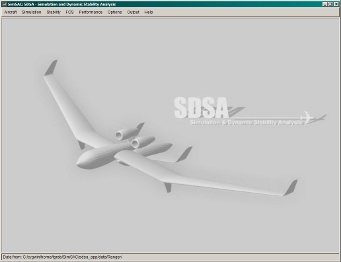Strona główna » ADD » Teaching » Software »
SDSA
Dynamic stability analyser
The SDSA (Simulation and Dynamic Stability Analysis) application covers the following functionalities:
- Stability analysis:
- eigenvalues analysis of linearised model in open and closed loop case
- time history identification (nonlinear model)
- 6 DoF simulation:
- test flights, incl. trim response
- turbulence
- Flight Control System including
- Human Pilot model
- Stability Augmentation System
- Actuator model
- LQR based FCS
- Performance
- Misc (data review, results review, cross plots, etc.)
The SDSA was designed to use the same nonlinear model of the aircraft motion for each functionality. For eigenvalues analysis, the nonlinear model was linearized numerically by computing the Jacobian matrix of the state derivatives around the equilibrium (trim) point. It allowed to construct the stability analyser using the same equation set as in the flight simulation. The flight simulation module was based on mathematical model with six degrees of freedom. It can be used to do the test flights in order to record flight parameters in time. Next they can be used for identification of the typical modes of motions and their parameters (period, damping coefficient, phase shift). The stability analysis results are presented on the figures of merits based on JAR/FAR, ICAO, MIL regulations. The SDSA also has embedded flight control system including: human pilot model, stability augmentation system, actuator models and FCS based on LQR idea. All control parameters can be edited directly from suitable GUIs. The LQR-FCS module allows to compute control matrices for all envelope and next save them for future use during simulation or stability analysis. All mentioned parts of FCS can be particularly turned on. Therefore embedded FCS allows to compute stability characteristics in “closed loop” case and make flight simulation with FCS.
The performance option is designed to compute basic performance parameters: flight envelope (Vmin and Vmax versus altitude of flight), selected manoeuvres (e.g. regular turn), range and endurance characteristics.
All mentioned functionalities use the same mathematical model with six degrees of freedom while the starting point should be computing of the trim state with sufficient initial conditions.
The SDSA was designed as the system of GUIs, which allows to set initial conditions, weather conditions, including gusts (wind shear) and turbulence. The test flight settings contain initial state disturbing and step (single, double) control. SDSA is a standalone application but it can be called directly from CEASIOM environment. Then, all necessary data (aerodynamics, mass, inertia, available thrust) are automatically sent to the SDSA. The main functionalities can be also chosen directly from the CEASIOM environment.
SDSA is available for MS Windows and Linux systems as well.
The package is provided as Freeware
Downloads:
SDSA 2024 beta
- MS Windows installation version 64 bit (updated: 2.09.2024, rev.1132)
SDSA 2020
- MS Windows installation version combined 32/64 bit (updated: 4.02.2021, rev.1004)
- MS Windows installation version 32 bit (updated: 4.02.2021, rev.1004)
- MS Windows installation version 64 bit (updated: 4.02.2021, rev.1004)
- Linux installation version 32 (updated: 28.11.2020, rev.999)
- Linux binary version 32 (updated: 28.11.2020, rev.999)
- Linux installation version 64 (updated: 28.11.2020, rev.999)
- Linux binary version 64 (updated: 28.11.2020, rev.999)
With any suggestions/complaints please write to:
including a word "SDSA" in the message title.


